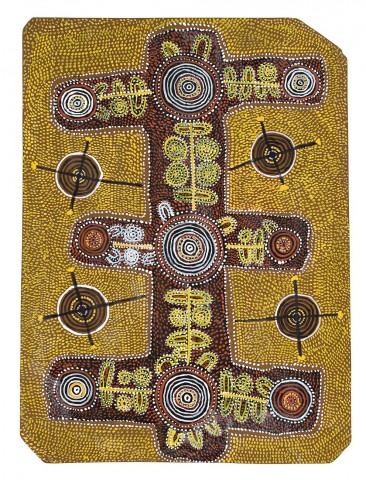UNTITLED (YUMARI), 1972
Attributed to UTA UTA TJANGALA
synthetic polymer paint on composition board
48.5 x 36.0 cm
Private collection, Alice Springs, acquired in the 1970s
Thence by descent
Private collection, Melbourne
Deutscher and Hackett, Melbourne, 25 March 2009, lot 88 (as ‘Artist Unknown (Pintupi), Untitled (Ceremonial Ground), c.1972’)
Private collection, Sydney
Untitled (Old Men's Story), 1972, synthetic polymer paint on composition board, 46.0 x 61.0 cm, Stuart Art Centre cat. 12032, Private collection, Melbourne, illus. in Ryan, J. and Batty, P., Tjukurrtjanu: Origins of Western Desert Art, National Gallery of Victoria, Melbourne, 2011, p. 139
Yumari, 1976, acrylic paint on canvas, 170.0 x 330.0 cm, in the collection of the National Museum of Australia, Canberra
There are recurring themes in the art of Uta Uta Tjangala and the best known of these relate to Yumari, a rockhole and important ancestral site in his mother's country. This early depiction attributed to the artist was painted at Papunya in the later months of 1972, shortly after Geoff Bardon’s departure. A sacred site located in between the communities of Walungurru (Kintore) and Kiwirrkura across the border in Western Australia, Yumari had personal significance for the artist. He was the custodian of this site which is linked to his conception place at Ngurrapalangu through the story of Yina, the ancestral travelling Old Man. His father is buried in the area and it is a place he regarded as home in the sense of the Aboriginal connection to country – Yumari was integral to Tjangala’s personal identity.1
The attribution of both artist and the site depicted have been made independently by R.G. (Dick) Kimber and Professor Fred Myers. Kimber notes that the overall design is a variation of many that the artist painted of Yumari prior to his later depictions of the site as ‘a stylised human figure’ and that the colour palette is one favoured by the artist.2
Connected to the mythological story of Yina, Yumari, with the literal meaning of ‘mother-in-law place’3, is where the revered ancestor had an illicit liaison with his ancestral mother-in-law. Yina is described as a sorcerer, possessing supernatural powers, whose testicles and penis repeatedly separated from his body and transformed into features of the landscape. Rocky outcroppings, a rockhole and various markings found within a few hundred metres of this site are interpreted as being the result of the illicit actions of the mythological beings.
One of the original band of artists that in 1971 initiated the revolution in Australian Aboriginal desert painting at the community of Papunya, Uta Uta Tjangala was a member of the Pintupi, the last group to be brought in to the government run settlement. A man of high ritual status with deep ancestral knowledge, he created some of the great masterpieces of the modern Western Desert painting movement, from his first paintings on composition board to later monumental canvases produced in the 1980s. Two later epic works relate to this site, the first of which, Yumari, 1981, was exhibited at the XVII Biennale de São Paulo. This painting was also shown with, Yumari, 1983, in Dreamings: The Art of Aboriginal Australia, the major exhibition that toured through the United States and Australia in 1988 – 89. Another painting related to the site is Old Man’s Dreaming, 1983, now in the collection of the Art Gallery of South Australia, Adelaide, which was included in the exhibition Australia at the Royal Academy, London, in 2013.
1. Myers, F.R., Painting Culture: The Making of an Aboriginal High Art, Duke University Press, Durham and London, 2002, pp. 112 – 3
2. Correspondence from R.G. Kimber.
3. Myers, F.R., op. cit. p. 112
CRISPIN GUTTERIDGE
